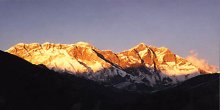Measuring Mountains

 |
The world's highest peak and past pretenders to the throne
by Borgna Brunner |
 A view of Everest from Thangboche Monastery. Related Links |
Peak XV: Goddess of the Sky
Called Chomolungma ("goddess mother of the world") in Tibet and Sagarmatha ("goddess of the sky") in Nepal, Mount Everest once went by the pedestrian name of Peak XV among Westerners. That was before surveyors established that it was the highest mountain on Earth, a fact that came as something of a surprise—Peak XV had seemed lost in the crowd of other formidable Himalayan peaks, many of which gave the illusion of greater height.
The Great Trigonometrical Survey Arbitrates
In 1852 the Great Trigonometrical Survey of India measured Everest's elevation as 29,002 feet above sea level. This figure remained the officially accepted height for more than one hundred years. In 1955 it was adjusted by a mere 26 feet to 29,028 (8,848 m).
The mountain received its official name in 1865 in honor of Sir George Everest, the British Surveyor General from 1830—1843 who had mapped the Indian subcontinent. He had some reservations about having his name bestowed on the peak, arguing that the mountain should retain its local appellation, the standard policy of geographical societies.
The Andes Muscle In On the Action
Before the Survey of India, a number of other mountains ranked supreme in the eyes of the world. In the seventeenth and eighteenth centuries, the Andean peak Chimborazo was considered the highest. At a relatively unremarkable 20,561 feet (6,310 m), it is in fact nowhere near the highest, surpassed by about thirty other Andean peaks and several dozen in the Himalayas. In 1809, the Himalayan peak Dhaulagiri (26,810 ft.; 8,172 m) was declared the ultimate, only to be shunted aside in 1840 by Kanchenjunga (28,208 ft.; 8,598 m), which today ranks third. Everest's status has been unrivaled for the last century-and-a-half, but not without a few threats.
K2 Tries to Take the Cake
The most recent challenge came from a 1986 American expedition climbing K2 (28,250 ft., 8,611 m) in the Karakoram range in Pakistan. According to their measurements, K2 was actually 29,284 feet, beating Everest by a cool 256 feet. Had this figure been accepted, mountaineering history would have required drastic revision: Everest would have taken a back seat to K2, no longer the ne plus ultra of geographical extremes.
Everest Undergoes a Growth Spurt
K2 was left even further back in the clouds when Everest's official height was revised in 1999. On May 5, 1999, a team of nine climbers summited Everest, armed with state-of-the-art satellite measuring devices. Six months later the results of their survey were announced: Everest is in fact 29,035 feet (8,850 meters)—six feet or two meters higher than the last official (1955) measurement.
It is remarkable how accurate all the official measurements of Everest have been. Conducted 147 years earlier, the Great Trigonometrical Survey of India in 1852 recorded Everest's height at 29,002 feet—a mere 33 feet off the mark.







